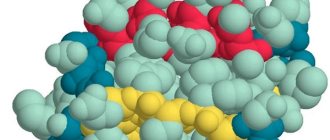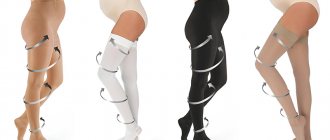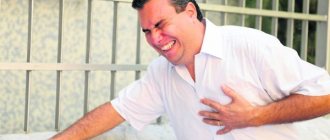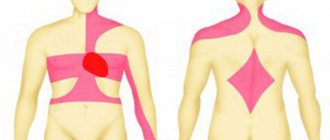0
Author of the article: Marina Dmitrievna
2017.07.26
734
Diagnostics
The procedure for taking an ECG is prescribed by a cardiologist if heart and vascular diseases are suspected. Some categories of citizens regularly undergo this examination due to chronic diseases or due to the nature of their professional activities. Patients who were first prescribed this diagnostic method are wondering why they need to do an ECG?
Description of the examination
An ECG for a child is similar to an ECG for an adult.
But this procedure still has its own nuances. ECG stands for electrocardiogram. This procedure records how the heart muscle contracts. How to do an ECG is familiar to many. To conduct this examination, sensors are fixed on a person, through which a signal is transmitted to a special device. This device produces a graph showing the work of the heart muscle. This procedure is quite simple and does not have any contraindications. It can be done for both adults and children. An ECG allows you to diagnose heart diseases such as heart disease, myocardial infarction, angina pectoris and others.
This examination is prescribed by any cardiologist when contacting him for a consultation. Your doctor can also tell you how to do an ECG. The advantages of this examination are that it is absolutely accessible, does not require any costs and allows you to diagnose heart diseases.
The heartbeat is accompanied by electrical impulses, which are recorded by a special device - a cardiograph. The device has several sensors that collect information from various points of the human body, which are located in the chest area, on the upper and lower extremities. A cardiogram represents waves on a graph corresponding to each phase of the heart rhythm.
The cardiograph produces a schedule according to which the specialist determines whether the patient has a particular pathology and draws up a suitable treatment regimen. The procedure is carried out quickly and has no absolute contraindications.
Using an ECG, cardiovascular diseases such as heart defects, myocardial infarction, inflammatory diseases, etc. are diagnosed. Not only the correct conduct of an ECG is important, but also preparation for it and a competent interpretation of the result. Only these measures taken together will make it possible to promptly identify and eliminate dangerous pathologies of the circulatory system.
How many times a year can the examination be done? An ECG is recommended to be performed once a year for persons over 40 years of age and patients with heart problems. How often a patient needs to be examined is determined by the doctor depending on his state of health.
We examine children. How is diagnosis carried out?
How to do an ECG for a child? First of all, it is worth saying that a pediatric electrocardiogram differs from an adult examination. This is due to the fact that the baby’s heart rate has its own characteristics in each age period. For example, newborns have a very rapid heartbeat. However, as you get older, it slows down.
Another important point is the high-quality equipment with which this procedure is carried out. Before undergoing this examination, it is recommended to clarify the qualifications of the doctor, look at reviews about him, find out what devices are used for conducting an electrocardiogram and how an ECG is performed in this clinic.
It is better if the technology is modern. Previously, ECGs were not performed on children. At that time, only one disease was detected in them - heart disease. But recently, unfortunately, children have various diseases of the cardiac system. Therefore, this type of examination is prescribed to diagnose them. It should also be said that it is always better to identify the disease at an early stage and take all necessary measures to improve the health of the body.
Standard research design
The doctor does an ECG as follows:
- Before installing the sensors, make sure that there are no metal jewelry on the patient’s body. The patient's body is freed from excess clothing, the upper torso, wrists and shins are exposed.
- The electrode attachment points are treated with special compounds to better attach the sensors to the skin surface.
- The person takes a horizontal position, lying on his back. Before doing an ECG, the doctor writes down all the information about the patient.
- The sensors are fixed on the body using special clamps. The devices are placed in the lower part of the forearms, the outer and inner areas of the legs.
- The chest leads are attached to the skin of the chest in 6 zones using adhesive tape.
- The sensors are connected to the device according to a certain scheme: the red wire is attached to the right hand; yellow – to the left upper limb; green - to the lower left, white - to the chest.
- Leads are registered. According to the standard scheme, sensors are registered through alternate connections: 1 lead - the sensor from the left upper limb is connected to the electrode of the right hand; Lead 2 – the sensor from the right upper limb is combined with the electrode of the left leg; Lead 3 – combines the sensors of the limbs located on the left side.
Standard scheme for performing an ECG
To register an electrocardiogram, the patient is recommended to follow some rules:
- during the diagnostic procedure, breathe evenly and avoid emotional overload;
- do not eat 2-3 hours before the procedure;
- patients with severe shortness of breath are recommended to perform the procedure in a sitting position;
- Women should remove their bra.
Patients who have never had an ECG often ask: how long does the study take? Answer: about 3-5 minutes. Another question that interests women is whether it is necessary to take off their bra before an ECG? Answer: when recording an ECG, suction cups are placed on the surface of the skin of the chest, and any materials, including a bra, create interference.
ECG for women
To examine heart rhythms that appear only during physical activity, non-standard ECG schemes are used, for example, a stress test. Heart rate measurements are taken after exercise on a treadmill or bicycle. If the patient has contraindications to physical activity, then to conduct a stress test, he is injected intramuscularly with drugs that stimulate the heart.
Stress tests are prescribed to diagnose a patient with coronary heart disease in the early stages of development, which does not manifest itself with characteristic symptoms.
Several hours before the procedure, alcoholic and caffeine-containing drinks are excluded from the diet.
Performing a stress test
If stress tests record abnormal values, then the diagnosis is carried out with hyperventilation. What is this technique used for? Nonspecific changes in the cardiogram can appear for two reasons - due to increased physical activity or as a result of diseases of the cardiovascular system.
To understand the cause of the anomaly, the doctor asks the patient to breathe evenly and deeply. During this time, adaptive changes occur in the body, and the line on the ECG takes on a normal physiological appearance. If after hyperventilation the heart rate increases two or more times relative to the control result, then the test is considered positive. This indicates that the patient has neurocircular dystonia.
If the patient has a predisposition to an irregular rhythm, then he is prescribed Holter monitoring. In this case, using a standard scheme it will not be possible to detect the deviation in a few minutes. The device for Holter monitoring has 2, 3 or 12 valves. It is worn for 24-48 hours.
Holter monitoring device
How to wear the device correctly? Self-adhesive sensors are attached to the treated areas of skin. The wires coming from the electrodes go to the recording apparatus. During research, a person can lead a normal lifestyle.
The main condition during the study is to avoid getting the device wet. In parallel with Holter monitoring, the patient must record the moments when unpleasant signs appear in the heart area. The doctor will compare the notes taken with the readings from the device.
ECG, as a simple and at the same time reliable way to determine heart disease, has been used since 1873. The activity of the circulatory organ is affected not only by cardiovascular pathologies, but also by other disorders in the body. If unpleasant cardiac symptoms occur, do an ECG so that the doctor can track abnormalities in the functioning of the organ and prescribe a timely treatment regimen.
Going to a therapist
Contents
hide
1 Visit to a therapist
2 Review: 24-hour (Holter) ECG monitoring – Full description of the procedure. Prohibitions and recommendations. My experience.
3 Visiting a therapist 3.1 Materials used in the article:
I urgently needed to get a certificate for physical education at the university. Despite the fact that we only have 1 lecture per week (there are no practices for the first year), she promised to give passes to those who do not bring a certificate of health group (Basic, Preparatory, etc.) until October. Well, I sat in line, a pretzel came in front of me, and when he said “Come in already,” instead of going to the therapist who had already called him, he replied, “I’m not in a hurry.” A good thought comes later, so I couldn’t answer wittily, “Well then, let me go first.”











